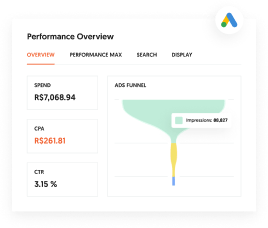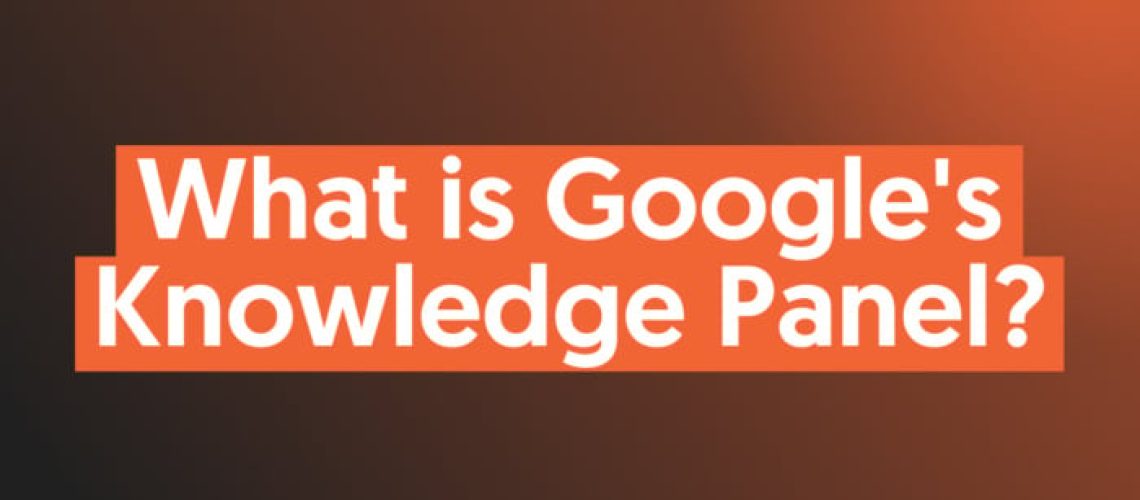People tend to connect with news sources they trust. As an author, you could be that news source.
However, building a large following is not easy in a world where so many voices are clamoring for attention. That’s why you need to leverage all resources available for you to stand out from the crowd.
One way is to claim your Google Knowledge Panel.
Why do you want to claim knowledge panels? You get to control the narrative. When you tell Google you’re the owner of that brand, you can make sure the information is accurate and up to date.
This is a critical step when you’re using SEO to build your brand.
Claiming knowledge panels for your brand is relatively easy, and it’s definitely something you want to get on top of to keep customers coming through your doors or to your website with consistency, arming them with the right information.
What Are Google Knowledge Panels?
So what is a knowledge panel? Well, you don’t have to use too much imagination.
Remember the last time you did a Google search for anything? The information you were looking for just popped up, towards the top of the screen, with relevant data all in one place.
Enter Google Knowledge Panels. You don’t have to know what they’re called to know what they are. They are the boxes of information you see near the top of a Google search for anything from a person to a brand.
Knowledge panels can include:
- a brand or entity name
- descriptions
- details about the person or brand
- history
- contact information
- featured images
According to Google, it uses different factors to decide what goes in that panel. As you start to look around, you’ll start to notice some information seems gathered from other sources, such as Wikipedia or other online websites.
Whenever source information changes, Google also automatically updates the author knowledge panel. To display the knowledge panel, search engines:
- receive a user’s query
- obtain search results for the query
- identify the first set of factual entities relevant to the query
- select the most relevant media to display in the knowledge graph
- verify that collected content is factual and relevant to the query
In addition, Google uses its data involving keyword searches and questions people tend to ask regarding that particular entity or item, and it pulls those questions and answers in.
It’s all based on Google’s Knowledge Graph.
Google uses all that data to build the knowledge panels you see when you search for something. These aren’t necessarily generated by the person who has claimed their Google Knowledge Panel.
Now, let’s look at a couple of knowledge panel search examples.
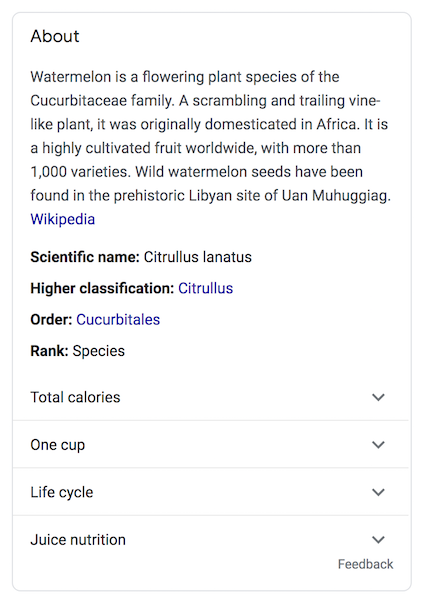
This one is about watermelons. It’s not specifically owned by anyone in particular and therefore, not claimable.
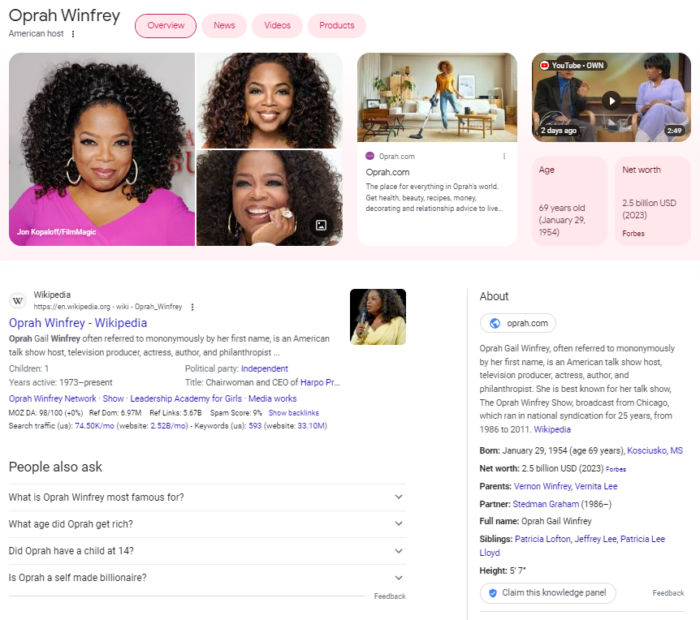
Here is an example of a Google Knowledge Panel for a person. She could go in and claim it using the button on the bottom right.
We’ll discuss more about how this works.
Why Should You Claim Knowledge Panels in Google?
Is it worth taking the time to claim knowledge panels in Google? If you’re the owner of a brand with a knowledge panel, you can verify your relationship to that entity and at least influence some of the information provided in the panel.
Here are a few reasons why you should invest time and effort in verifying it:
Increases Search Visibility
One of the most significant reasons you should invest time and effort in verifying and managing your author knowledge panel account is that it helps boost SEO. When people search for a query related to you or your brand, the first thing they’ll see on the SERPs is a knowledge graph featuring information about you and your business. Of course, increased search visibility results in increased traffic to your site and, ultimately, an uptick in revenue.
Boosts Brand Visibility
Another reason to verify your author panel is that it’s a great way to increase brand visibility. Because knowledge panels occupy a significant portion of SERP real estate, they offer unmatched brand visibility. Knowledge panels display all kinds of media, giving you incredible branding opportunities. From your name to your social media handles to key website pages, you have an opportunity to present searchers with all branding assets in one place.
Helps With Reputation Management
Reviews play a crucial role in establishing your online currency. Unfortunately, not everyone will leave positive reviews about your brand or products. Negative reviews can tarnish your image. This is where an author knowledge panel comes to the rescue. Since it appears right at the top of SERPs, it helps establish trust with users, helping you with your reputation management.
Improves User Experience
Search engines are all about providing users with the best possible user experience (UX). Verifying your author knowledge panel helps do this. Fortunately, you also get to benefit from the positive UX as it helps drive traffic to your website.
The Process to Claim Knowledge Panels in Google
Now you’re ready to claim knowledge panels that relate to you, your brand, or entities that you represent in Google. Here are some steps to get you started:
1. Sign in to Your Google Account
You need to have a Google account to be able to claim knowledge panels. If you have a Gmail address or other Google product where you’ve set up an account, then you are good to go. If not, go ahead and set one up. To continue, you’ll need to be logged in.
Now log in to your preferred Google account. If you use a specific account for your brand or your related business needs, sign in to that one.
2. Search for the Knowledge Panel Topic
Once you’re logged in, use Google to search for yourself, your brand, your entity, or your organization. It may seem self-explanatory, but you need to actually type in the entity for the knowledge panel you’re looking for.
The goal here is to see the knowledge panel as users see it.
What information does it display? Are there plenty of images to show the audience? What impression do the reviews leave on the business?
This is the type of information that demonstrates your business is reputable and trustworthy.
Now that you’ve searched for it, you should see the brand or other name at the top of the knowledge panel. If not, search again; many brands or organizations have similar or even identical names, so make sure you see yours before continuing. You don’t want to accidentally claim someone else’s—or get stuck not being able to claim your own.
3. Click the Claim Knowledge Panels Link
Look for the link on the bottom that says, “Claim This Knowledge Panel.”
The button is located at the bottom of the box surrounding the knowledge panel. The size may vary, but all are surrounded by a thin line.
Go ahead and click the link. If you don’t see it, the knowledge panel may already be claimed by another entity. Make sure you’re looking at the right panel.
Here, you will be able to review the available features. As we mentioned above, knowledge panels are not created by those who claim or verify them. Google uses various algorithms and machine knowledge to pull what it deems to be relevant information into these panels.
4. Look for Profiles You Can Use to Claim Knowledge Panels
Google uses a number of different connections on other web platforms that you can sign into to prove your identity or relation to the knowledge panel you want to claim. You can choose from YouTube, Facebook, Twitter, and more. Once you sign in to one of these, you’ve claimed your knowledge panel and can make updates or changes as available.
5. Give Others Access
Once you’ve gone through all the work to claim your knowledge panel, you may also want to make sure other people on your team have access to your brand’s knowledge panels so you can all collaborate with the same information. With access to the same information, your team can be more consistent, stay up to date on any changes, and streamline your overall workflow.
To do this, you need to be logged in to the same Google account you used to claim the panel. Go to Google’s Manage User page.
Click to add people and then add the email addresses of those you want to give access to your knowledge panels. Choose which levels of permission you want to give them. Every level has the option to go in and suggest changes to your knowledge panel, which we will discuss in more detail below. However, an owner or manager can add or delete others from access.
7 Steps to Update Your Google Knowledge Panel
Now that you have verified yourself and have claimed your knowledge panel, you can begin the work of actually managing it.
This won’t eat up all your time or require constant maintenance, but you may want to check in every once in a while. If you do see an error in your Google Knowledge Panel or if one has been reported to you, you can take certain steps to make necessary updates. It’s at Google’s discretion, however, so it may take some time and patience.
1. Sign In
Make sure you’re logged in to the Google account you used to claim your knowledge panel, or the one someone used to gain you access to the knowledge panel. Otherwise, Google won’t recognize you as someone related to that account.
In addition, you need to turn on “Web and App Activities” under Google’s Activity Controls in your Google account. Essentially, this helps track your steps as you are moving around your searches and helps Google ensure you have access to the knowledge panel.
2. Search for the Knowledge Panel
Just as when you claimed your knowledge panel, you need to use Google Search to look for the entity whose knowledge panel you want to update. Googling your brand’s name is probably the best and easiest way to get there, but remember to look carefully at the knowledge panel and make sure it’s referencing the entity you intended. If not, keep searching until you find the right one.
3. Click Suggest Edits
If you are logged in to the correct Google account and are looking at the associated knowledge panel, you should see a link at the top of the knowledge panel that says “Suggest Edits” or a similar iteration. If you don’t see it, verify you are signed in correctly and are looking at the right knowledge panel.
When you are, go ahead and click it. This is your portal for suggesting updates.
4. Choose What You Want to Update
Click the area you want to update. You will be doing each one separately, so if you have more than one change you would like to see, just start with one, and you can continue with more changes later.
Areas you want to update might include images, descriptions or titles, social media profile links, and more.
Here is an example using Boden’s knowledge panel. You can see how each bit of information is broken into different options. You can choose which section you want to suggest an update for.
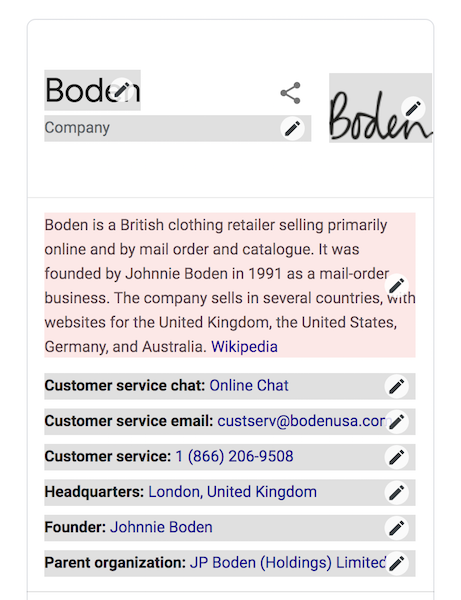
5. Write Out Your Suggested Updates
Because this is Google’s product and not one you can directly control yourself, you can’t just go in and make updates on the areas you would like.
You can, however, ask Google to go in and review your suggestions.
When you click on the area you want to update, a small text box will open where you can enter your suggested update.
Be as specific as possible and provide as much background as you can. This helps the reviewer on Google’s end have as much context as possible to understand the logic behind the suggested change. You can also provide links to any websites or pages to verify your requested change.
6. Wait
This isn’t the easy part, but you will have to wait for your review to be accepted. Google will manually review your suggestion and check for verifiable information online to back up your update for accuracy. That’s why providing the specifics and URLs as mentioned above is important.
When Google accepts your updates, you will be contacted via email.
7. Create More Suggestions
You should send each update as a separate request. In other words, if you want to see the image updated as well as social media profile links, you should do these separately.
This keeps the review process clean and easy to follow. It also allows you to be specific and detailed without muddling your requests.
Get in there and make suggestions for updates whenever you deem necessary.
How to Get a Google Author Knowledge Panel
What happens when you search for your entity, and you don’t appear in a knowledge panel?
This usually happens when there isn’t enough factual information on the internet for Google to verify and add to its Knowledge Graph. As a result, it can’t generate an author knowledge panel.
So you now might be wondering how to get a Google Knowledge Panel of your own.
Here’s what I would do.
Get Featured on a Wikipedia Page
Wikipedia is one of the trusted sources Google turns to when gathering information for its Knowledge Graph. One reason for this is the strict guidelines Wikipedia has put in place to ensure all pages published on the platform are accurate and contain no bias. Therefore, being featured on the platform hooks you up to one of the most reliable sources of information on the internet.
One of the best ways to be featured is to build Wikipedia backlinks. The easiest way to do this is by looking for and fixing broken links on Wikipedia. Use a tool like WikiGrabber to find pages that have broken links or need a reference.
Another way is to reach out to an independent Wikipedia editor to create a page for you or mention you on other pages.
Granted, getting featured on Wikipedia can be quite an uphill task. If you want an easier route, you can consider Wikidata. This is a data bank that feeds structured data to Wikimedia projects. Since Google shut down Freebase, their open-source repository that powered the Knowledge Graph, it also relies on data from Wikidata.
Leverage Your Website
Knowledge Graph also pulls information from websites. To leverage your website for building the necessary critical mass you’ll need, you must:
- Use schema markup: Schema markup, or structured data, helps Google understand what you and your website. Done well, it will point Google to all the corroborative data that serves as evidence of your authorship.
- Have a detailed “About Us” page: Your “About Us” page must explain who you are and what you do. Also, include links to relevant publications that can verify who you are and what you do.
- Piggyback on your connections: If you have connections who already appear in knowledge panels, strategically mention them on your website, link to their entities, or add them to your schema markup.
Investing in an optimized website and well-structured content is an essential step to getting information about yourself pulled into the Knowledge Graph.
Get Yourself Featured on Third-Party Websites
Another way to give engines more factual knowledge about you is to get featured in reputable publications. A few effective ways to do this include:
- Guest posting: Publishing articles on authority news sites helps you create more digital assets to provide Google with data about you. It’s also a great way to establish yourself as a reliable source of information.
- Speaking at events: Both online and in-person events allow you to be mentioned on third-party sites, helping you collaborate on your authorship claims.
- Conducting interviews: Interviewing relevant people in your industry gives you new insight and expertise for content to share online, as well as new relationships to create backlinks with.
- Create collaborative content: Creating content with other experts in your industry helps build your brand’s authority and consequently reach a wider audience to connect with.
- Participating in expert roundups: By sharing your own input for others’ content, you can showcase your brand to new audiences.
The more you appear on the web, particularly on reputable and relevant sites, the higher your chances of appearing in a knowledge panel.
Ramp Up Your Social Media Presence
Social media has become more than just a way to keep in touch with family and friends. It has become one of the ways you can prove your identity online. That’s why optimizing your social media profiles and being active is a great way to increase your Knowledge Graph.
Creating content that your audience will interact with, and share, will help boost your online presence, powering your Knowledge Graph.
Getting into the Knowledge Graph is essential to the generation of your author knowledge panel. Do everything you can to ensure you give search engines enough factual data about yourself.
Doing so will ensure that you are recognized as an entity worthy of a knowledge panel. Also, make sure to keep “feeding” the Knowledge Graph with updated information. This is essential in ensuring your knowledge panel is populated with the latest data on you.
FAQs
Google Knowledge Panels are totally free! However, they aren’t easy to get. You need to earn a knowledge panel with quality products and services alongside thorough SEO optimization.
You should absolutely claim your Google Knowledge Panel to signal that you “own” it. This grants you access to your Google Business Profile, which helps you manage your online presence.
Google scours data stored in the Knowledge Graph and determines what entities receive knowledge panels by looking at your brand’s authority, relevance, and location.
It can take anywhere from two to four weeks for Google to verify or deny your knowledge panel submission.
If you haven’t heard back in four weeks, you may want to call Google Support and try the process again.
Google Knowledge Panel is the SERP display that highlights relevant information about an online entity, whether that be an influential figure, a company, or small business. On the other hand, Google Business Profile is a dashboard where you can manage the information that appears on the knowledge panel. Note that what appears in a search for a given business can vary. If your search is on a greater business entity, you may get a Knowledge Panel if there is one. Google Business Profiles would appear for searches for individual locations. A business can have both, but they are designed for different search needs.
If you seem to have lost your Google Knowledge Panel, it could mean that someone reported it for being incorrect or for violating Google’s search policy.
If you think there’s been a problem, consider reaching out to Google Business Profile Support or a Google Ads rep to troubleshoot the situation.
Conclusion
Knowing what people are learning about you and your brand is key to understanding how the public perceives you. If the information at the top of a Google search isn’t accurate or isn’t reflective of what you want to project, you need to claim knowledge panels and request those updates are made.
Claiming knowledge panels can give you at least a little more control over how your brand appears in a Google search, but it’s not the end all be all. In fact, it’s just one step in building an online brand and SEO.
There’s so much you can do to improve your SEO and stay in front of your customer base with the knowledge they need to interact with your brand well.
Have you claimed your brand’s Google Knowledge Panel yet?

See How My Agency Can Drive More Traffic to Your Website
- SEO – unlock more SEO traffic. See real results.
- Content Marketing – our team creates epic content that will get shared, get links, and attract traffic.
- Paid Media – effective paid strategies with clear ROI.
Book a Call
Are You Using Google Ads? Try Our FREE Ads Grader!
Stop wasting money and unlock the hidden potential of your advertising.
- Discover the power of intentional advertising.
- Reach your ideal target audience.
- Maximize ad spend efficiency.
